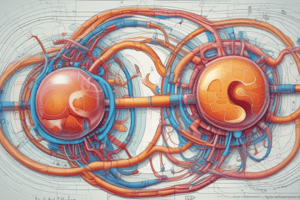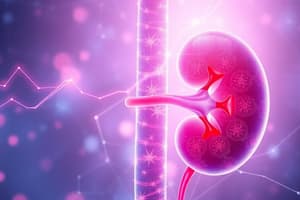Podcast
Questions and Answers
What is the primary role of mTORC1 in cellular processes?
What is the primary role of mTORC1 in cellular processes?
How is SIRT1 primarily activated?
How is SIRT1 primarily activated?
What is a significant effect of PGC-1⍺ activation?
What is a significant effect of PGC-1⍺ activation?
Which enzyme is primarily regulated by SIRT3?
Which enzyme is primarily regulated by SIRT3?
Signup and view all the answers
What process is primarily inhibited by AMPK in relation to mTORC1?
What process is primarily inhibited by AMPK in relation to mTORC1?
Signup and view all the answers
Which factor is associated with the senescence-associated secretory phenotype (SASP)?
Which factor is associated with the senescence-associated secretory phenotype (SASP)?
Signup and view all the answers
What is one of the primary roles of SIRT4 in cellular metabolism?
What is one of the primary roles of SIRT4 in cellular metabolism?
Signup and view all the answers
What does the activation of NRF1 primarily influence?
What does the activation of NRF1 primarily influence?
Signup and view all the answers
Which of the following statements correctly describes the role of AMPK?
Which of the following statements correctly describes the role of AMPK?
Signup and view all the answers
Which cellular response is associated with aging and nephron loss?
Which cellular response is associated with aging and nephron loss?
Signup and view all the answers
What role does the renal Na+ pump play in kidney energetics?
What role does the renal Na+ pump play in kidney energetics?
Signup and view all the answers
Which nephron segments are predominantly responsible for gluconeogenesis?
Which nephron segments are predominantly responsible for gluconeogenesis?
Signup and view all the answers
What is a significant outcome of transporter competition in renal drug metabolism?
What is a significant outcome of transporter competition in renal drug metabolism?
Signup and view all the answers
Where is the highest density of mitochondria found in the nephron?
Where is the highest density of mitochondria found in the nephron?
Signup and view all the answers
Which compound is primarily involved in the metabolic pathways impacted by CYPs in kidneys?
Which compound is primarily involved in the metabolic pathways impacted by CYPs in kidneys?
Signup and view all the answers
Which of the following statements accurately describes the role of 20-HETE?
Which of the following statements accurately describes the role of 20-HETE?
Signup and view all the answers
Which processes in the kidneys depend heavily on membrane transport?
Which processes in the kidneys depend heavily on membrane transport?
Signup and view all the answers
Which nephron segment has the highest activity of the Na+/K+ ATPase?
Which nephron segment has the highest activity of the Na+/K+ ATPase?
Signup and view all the answers
How does reactive oxygen species (ROS) affect renal mitochondria?
How does reactive oxygen species (ROS) affect renal mitochondria?
Signup and view all the answers
What is the primary site for drug metabolism within the nephron?
What is the primary site for drug metabolism within the nephron?
Signup and view all the answers
What role does NADPH oxidase (NOX2 & NOX4) play in cellular processes?
What role does NADPH oxidase (NOX2 & NOX4) play in cellular processes?
Signup and view all the answers
Which enzyme is responsible for reducing superoxide anions to hydrogen peroxide?
Which enzyme is responsible for reducing superoxide anions to hydrogen peroxide?
Signup and view all the answers
What effect does mitochondrial uncoupling protein 2 (UCP2) have in response to ROS?
What effect does mitochondrial uncoupling protein 2 (UCP2) have in response to ROS?
Signup and view all the answers
Which transcription factor is primarily activated to stimulate mitochondrial biogenesis?
Which transcription factor is primarily activated to stimulate mitochondrial biogenesis?
Signup and view all the answers
What is the process of mitophagy primarily responsible for?
What is the process of mitophagy primarily responsible for?
Signup and view all the answers
Which factor activates PGC-1⍺ through the cGMP pathway?
Which factor activates PGC-1⍺ through the cGMP pathway?
Signup and view all the answers
What role does glutathione peroxidase (GPX) play in cellular function?
What role does glutathione peroxidase (GPX) play in cellular function?
Signup and view all the answers
How does the process of mitochondrial fusion benefit the mitochondria?
How does the process of mitochondrial fusion benefit the mitochondria?
Signup and view all the answers
What metabolic pathway is primarily regulated by mTOR in mitochondria?
What metabolic pathway is primarily regulated by mTOR in mitochondria?
Signup and view all the answers
What is the relationship between reactive oxygen species (ROS) and the activation of NRF2?
What is the relationship between reactive oxygen species (ROS) and the activation of NRF2?
Signup and view all the answers
Which nephron segment is primarily responsible for the majority of gluconeogenesis?
Which nephron segment is primarily responsible for the majority of gluconeogenesis?
Signup and view all the answers
What role do the renal mitochondria play in the production of reactive oxygen species (ROS)?
What role do the renal mitochondria play in the production of reactive oxygen species (ROS)?
Signup and view all the answers
Which factor is primarily increased by 20-HETE's action in the kidneys?
Which factor is primarily increased by 20-HETE's action in the kidneys?
Signup and view all the answers
What is a significant consequence of transporter competition in renal drug metabolism?
What is a significant consequence of transporter competition in renal drug metabolism?
Signup and view all the answers
Which of the following nephron segments has the highest mitochondrial density?
Which of the following nephron segments has the highest mitochondrial density?
Signup and view all the answers
Which factor directly initiates the transcription of genes involved in mitochondrial biogenesis?
Which factor directly initiates the transcription of genes involved in mitochondrial biogenesis?
Signup and view all the answers
What is the primary action of mitochondrial uncoupling protein 2 (UCP2) in response to reactive oxygen species (ROS)?
What is the primary action of mitochondrial uncoupling protein 2 (UCP2) in response to reactive oxygen species (ROS)?
Signup and view all the answers
What is the primary outcome of the process of mitophagy?
What is the primary outcome of the process of mitophagy?
Signup and view all the answers
Which signaling molecule activates soluble guanylate cyclase (sGC) through the stimulation of endothelial nitric oxide synthase (eNOS)?
Which signaling molecule activates soluble guanylate cyclase (sGC) through the stimulation of endothelial nitric oxide synthase (eNOS)?
Signup and view all the answers
Which enzyme reduces hydrogen peroxide (H2O2) to water while producing glutathione disulfide (GSSG) as a byproduct?
Which enzyme reduces hydrogen peroxide (H2O2) to water while producing glutathione disulfide (GSSG) as a byproduct?
Signup and view all the answers
Flashcards
Kidney Energetics
Kidney Energetics
The kidney's high oxygen consumption, blood flow, and susceptibility to hypoxic injury, requiring lots of ATP for function.
Renal Na+/K+ Pump
Renal Na+/K+ Pump
Crucial for cellular respiration in the kidney, acting as a "pacemaker" for this process.
Drug Metabolism in Proximal Tubules
Drug Metabolism in Proximal Tubules
Primary site in the kidney for drug metabolism, including both phase I and phase II reactions.
Nephron Segments & Glucose Oxidation
Nephron Segments & Glucose Oxidation
Signup and view all the flashcards
Drug-Drug Interactions (Renal)
Drug-Drug Interactions (Renal)
Signup and view all the flashcards
Gluconeogenesis in Kidney
Gluconeogenesis in Kidney
Signup and view all the flashcards
20-HETE
20-HETE
Signup and view all the flashcards
CYPs in Drug Metabolism
CYPs in Drug Metabolism
Signup and view all the flashcards
Renal Mitochondrial ROS
Renal Mitochondrial ROS
Signup and view all the flashcards
Mitochondrial Density Variation
Mitochondrial Density Variation
Signup and view all the flashcards
Reactive Oxygen Species (ROS)
Reactive Oxygen Species (ROS)
Signup and view all the flashcards
NADPH Oxidase
NADPH Oxidase
Signup and view all the flashcards
NRF2
NRF2
Signup and view all the flashcards
Mitochondrial SOD2
Mitochondrial SOD2
Signup and view all the flashcards
Glutathione Peroxidase (GPX)
Glutathione Peroxidase (GPX)
Signup and view all the flashcards
Mitophagy
Mitophagy
Signup and view all the flashcards
Mitochondrial Fusion
Mitochondrial Fusion
Signup and view all the flashcards
Mitochondrial Fission
Mitochondrial Fission
Signup and view all the flashcards
Mitochondrial Biogenesis
Mitochondrial Biogenesis
Signup and view all the flashcards
PGC-1α
PGC-1α
Signup and view all the flashcards
NRF1 & NRF2
NRF1 & NRF2
Signup and view all the flashcards
mTOR
mTOR
Signup and view all the flashcards
mTORC1
mTORC1
Signup and view all the flashcards
mTORC2
mTORC2
Signup and view all the flashcards
AMPK
AMPK
Signup and view all the flashcards
Sirtuins
Sirtuins
Signup and view all the flashcards
SIRT1
SIRT1
Signup and view all the flashcards
SIRT3
SIRT3
Signup and view all the flashcards
Cellular Senescence
Cellular Senescence
Signup and view all the flashcards
Nephron Loss
Nephron Loss
Signup and view all the flashcards
What are the key triggers of mitochondrial biogenesis?
What are the key triggers of mitochondrial biogenesis?
Signup and view all the flashcards
Fusion vs. Fission
Fusion vs. Fission
Signup and view all the flashcards
Kidney Energetics: Why so much ATP?
Kidney Energetics: Why so much ATP?
Signup and view all the flashcards
Drug Metabolism in the Kidney: Where does it happen most?
Drug Metabolism in the Kidney: Where does it happen most?
Signup and view all the flashcards
Renal Na+/K+ ATPase: What's its role?
Renal Na+/K+ ATPase: What's its role?
Signup and view all the flashcards
EETs & 20-HETE: What are they and what do they do?
EETs & 20-HETE: What are they and what do they do?
Signup and view all the flashcards
Mitochondrial Density in Kidneys: Where are they busiest?
Mitochondrial Density in Kidneys: Where are they busiest?
Signup and view all the flashcards
Study Notes
Kidney Energetics and Metabolism
- Kidneys have high oxygen consumption and are susceptible to hypoxic injury.
- They heavily rely on ATP for functions like the sodium pump.
- Kidney function in drug metabolism is significant, impacting drug efficacy and toxicity via excretion and metabolism.
- Key processes include glomerular filtration, reabsorption, and secretion.
- Different kidney regions (PCT, TALH, DCT, collecting tubules) have varied capacities for glucose and lactate oxidation, with the collecting tubules having maximum aerobic glycolysis.
- Drug metabolism and metabolic differences exist between nephron cell types. Gluconeogenesis is prominent in proximal tubules.
Mitochondrial Function in Kidneys
- Mitochondrial density is highest in proximal tubules (PCT, mTALH).
- Drug metabolism primarily occurs in proximal tubules, encompassing phase I and II enzymes.
- Eicosanoids (HETEs and EETs) are derived from arachidonic acid by cytochrome P450 enzymes (CYPs).
- CYPs are important for drug metabolism but also in metabolism of endogenous substances.
Redox Balance and Renal Mitochondria
- Redox balance is crucial for renal mitochondrial function.
- Reactive oxygen species (ROS) can damage mitochondrial DNA (mtDNA) leading to aberrant proteins and further ROS production.
- Enzymes like NADPH oxidase contribute to ROS production.
- Nrf2, a transcription factor, is activated by ROS, activating antioxidant responses.
Mitochondrial Biogenesis and Regulation
- Maintaining mitochondrial homeostasis is crucial.
- Mitophagy is the process by which damaged mitochondria are degraded.
- Cellular processes like growth and proliferation are regulated by mTORC1, responding to nutrients and oxidative stress.
- AMPK, similar to mTORC1, plays a critical role in catabolic processes.
- Sirtuins (SIRT1, SIRT3, SIRT4) regulate mitochondrial acetylome and also influence processes like beta-oxidation and urea cycle.
Aging and Kidney
- Kidney function declines with age due to nephron loss and hypertrophy.
- Cellular senescence (permanent cell cycle arrest) occurs due to damage like telomere shortening, DNA damage, and ROS.
- Cellular hypertrophy is associated with interstitial fibrosis, tubular atrophy, glomerulosclerosis, microvascular rarefaction, and podocyte hypertrophy.
Studying That Suits You
Use AI to generate personalized quizzes and flashcards to suit your learning preferences.
Description
This quiz explores the energetics and metabolic functions of the kidneys, emphasizing their high oxygen consumption and roles in drug metabolism and excretion. Key processes such as glomerular filtration and the unique metabolic capacity of different nephron regions are discussed, alongside mitochondrial function and enzyme activity in the proximal tubules.




